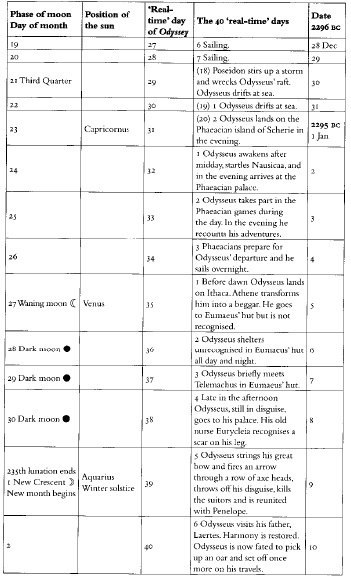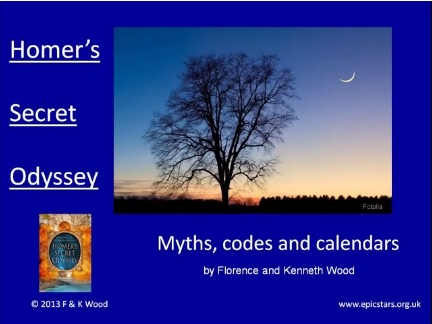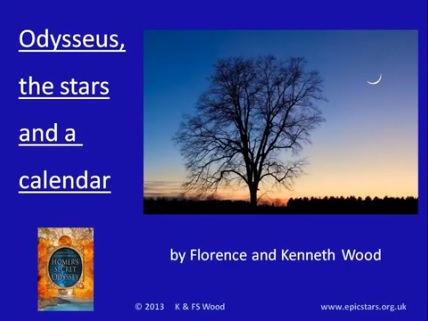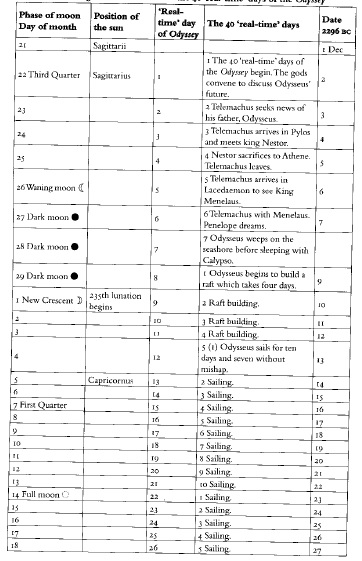Edna Leigh and Homeric epic
Homer the astronomer
Florence and Kenneth Woods' YouTube videos are an excellent introduction to the work of Florence's mother Edna Leigh, as presented in their two books Homer's Secret Iliad and Homer's Secret Odyssey:
Homer's Secret Iliad
A fine example of Homer's allegorical technique, as revealed by Leigh, is the character of Achilles, the most memorable of all the gods an heroes of the Iliad. Achilles' eminence is appropriate, as he represents Sirius, the alpha star of the constellation Canis Major, and the brightest star in the heavens. His return to the battle field portrays the return to the skies of Greece of Sirius in 8900 BC, due to the precession of the equinoxes, an astronomical effect which is a major theme of the Iliad. Achilles' regiment of Myrmidons reresents the minor stars of Canis Major. Homer for once is explicit about this identification: 'King Priam was first to note [Achilles] as he scoured the plain, all radiant as the star which men call Orion's hound...' (22.25, quoted in HSI p.73)'
The Catalogue of Ships identifies twenty-nine Greek and sixteen Trojan regiments, which represent forty-five constellations comprising approximately 650 stars. The leader of each regiment is the brightest star of that constellation: thus Achilles is alpha Canis major and Agamemnon is, as I have shown also to be the case in Aeschylus' Oresteia, Regulus, alpha Leonis. The city of Troy itself is the constellation Ursa Major, which was destined to decline, due to the precssion of the equinoxes, from its pre-eminent position next to the pole star, even as that star itself - Thuban, alpha Draconis, represented in the Iliad by the Greek warrior Arcesilaus - ceded its place as pole star to Kochab, beta Ursae Minoris, in approximately 1800 BC. Thus the fall of Troy was as inevitable as the astronomical effect it portrays.
Homer employed the techniques of the Rule of Wounding and the Rule of Magnitude. According to the former, a warrior wounded in the eye, for example, is allocated to a star in the 'eye' region of his constellation. The Woods note that, 'The effectiveness of this rule is remarkable.' The Rule of Magnitude determines that if warrior A kills warrior B, then the star represented by A must be the brighter. These two rules enabled Homer to build up a detailed and accurate picture of the heavens.
These few examples of course only scratch the surface of the remarkable construction that is the ILiad as astronomical allegory.
Homer's Secret Odyssey
There is another compelling item of evidence in the Odyssey which lends support to the thesis of the astronomical basis of the Oresteia, and the continuity of the allegorical technique of Homer and Aeschlyus. This is that the Feast of Apollo occurs on the penultimate day of the epic, which marks the appearance of the new crescent moon (HSO p. 31). I propose here that the radiant moon is a symbol in Aeschylus' Oresteia and Seven Against Thebes, and also Sophocles's Theban trilogy, of Apollo, god of the noonday sun and reason, and of the Athenian Apollonian miracle which had succeeded the old world with its supersitions and irrationalities.
Odysseus in fact represents the moon throughout the Odyssey, the key theme of which as allegory is the refinement of the calendar through alignment of lunar and solar time. Odysseus' experiences both before and after the fall of Troy are driven by the counting of lunations and cycles of the sun and moon. This chart (somewhat imperfectly scanned from Homer's Secret Odyssey, but it will give you the idea) shows how the Odyssey is arranged into units of time which incorporate a 19-year cycle of the sun and moon and an eight-year cycle of the sun, moon and Venus:



